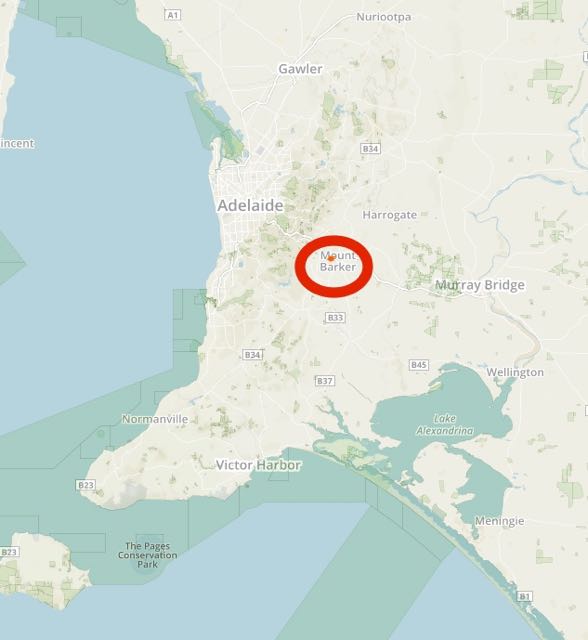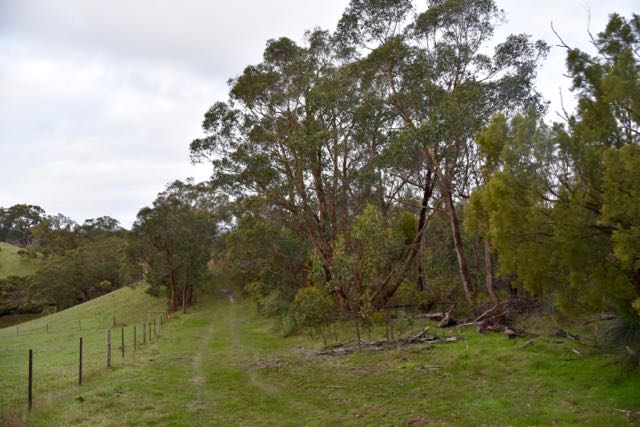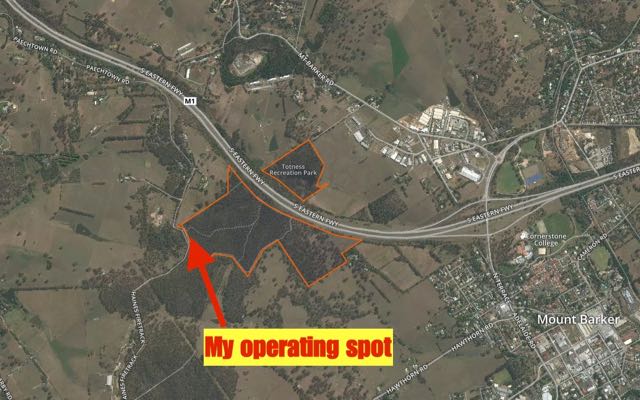I have been very busy in the past couple of weeks adding new Australian parks to the World Wide Flora (WWFF) program. And a few days ago a number of the South Australian parks that I added were approved by the WWFF Reference Managers. One of those being the Totness Recreation Park, VKFF-1754, which is located in the Central Mount Lofty Ranges ‘Adelaide Hills’, about 35 km south east of Adelaide, and just a few minutes drive from my home (just 2.5 km from the centre of Mount Barker). The weather was not flash, with intermittent showers, but I decided to head out to activate the park this afternoon (Wednesday 3rd August 2016).

Above:- Map showing the location of the Totness Conservation Park in the Adelaide Hills. Map courtesy of protected planet.
The land that is now Totness Recreation Park was formerly the property of the South Australian Railways and the Department of Transport. In 1970 the land was transferred to the (former) National Parks Commission and dedicated for reserve purposes, under the National Parks Act 1966. Totness Recreation Park was constituted on 22nd January 1972 under the new National Parks and Wildlife Act 1972 to protect natural habitat and provide recreational opportunities for the local community. The park comprises section 124, Hundred of Macclesfield. It was constituted free of access under State mining legislation.
In 2006, the Minister for Environment and Conservation released a discussion paper on a review of the reserve classification system in South Australia. Under the model proposed, Totness would become a Conservation Park. However, it appears that this paper has not progressed very far.
During the construction of the South Eastern Freeway, the park was dissected into two uneven portions totalling 41 hectares. The northern section comprises about 9 hecatares whilst the southern section comprises around 32 hectares. The dam in the northern section of the park was constructed in 1884 and was used to supply the steam locomotives travelling to and from Victor Harbour until 1955. The southern section was totally burnt out during the 1983 Ash Wednesday bushfires.
A variety of native plants and animals can be found in the park. More than 180 native plants species have been recorded within the park. Plant species of conservation significance recorded within the park include the state rare Manna Gum and Bassian Thrush, and the regionally rare Spider Orchid. Western Grey kangaroos, Common Ringtail Possums, Echidnas, Koalas, and various bat species can be found in the park. A total of 26 species of native bird have been recorded in the park, including the rare Shining Bronze cuckoo and declining woodland birds including the white-throated treecreeper, scarlet robin and Bassian thrush.
To access the northern section of the park you take Totness Road, which runs off the Old Mount Barker Road (Frank Walsh Drilling is located on the corner). But I headed to the southern section of the park. I headed out from home along Hawthorn Road, and then turned right onto Liebelt Summer Track. I then reached the intersection with Darby Road and Haines Fire Track and turned right onto Haines Fire Track.
Haines Fire Track is a dirt road and after all the recent heavy rain, had quite a bit of water across it and a number of potholes, but it is easily passable in a conventional vehicle. The park soon came in to view on my right. Don’t get confused with all of the other scrub that you pass before reaching the park. That is all private property.
For this activation I ran the Yaesu FT-857d, 40 watts and a selection of dipoles which u supported on the 7 metre heavy duty extendable squid pole. I used a fence post to support the radio.
There is a nice cleared area between the park boundary and the commencement of the scrub, so there was plenty of room to string out the dipoles. Although there was a locked gate, there was a pedestrian entry point into the park, which saved the issue to having to jump barbed wire fences.

I was set up and ready to go about 15 minutes earlier than my planned activation time. Just before 0400 UTC (1.30 p.m. South Australian local time) I headed to 7.144 and asked if the frequency was in use and Peter VK3PF replied to let me know that the frequency was clear. Peter was the first in my log for this brand new park. Peter had a very strong 5/9 plus signal and reciprocated with a 5/9 signal for me. This was followed by Steve VK7CW who was also 5/9 plus, then Geoff VK3SQ, and then Rick VK4RF/VK4HA. The band was fairly quiet with just a slight frying pan noise in the far background, and certainly no man made noise on the band.

Above:- Aerial shot showing my operating position in the north western corner of the park. Image courtesy of protected planet.
Roscoe VK3KRH called in running just 3 watts and with his beam was still 5/9 plus. What a signal. Soon after Rob VK4AAC/3 called me from the Snowy River National Park VKFF-0455 with a 5/9 signal. It was nice to get my first Park to Park contact from Totness. Despite it being a week day I had a steady flow of callers from all across Australia (VK2, VK3, VK4, VK5, VK6, and VK7). Mike VK6MB called in from Perth but sadly we were unable to make a valid contact as Mike was having difficulty in hearing me. Greg VK5GJ called in from Meadows, running his normal 4 watts, and had a solid 5/8 signal. Soon after Mike VK6MB called back in again, and this time we were able to exchange signal reports and make a valid contact. Another QRP caller was Nev VK5WG, running just 5 watts from the Mid North of South Australia. Nev had a solid 5/9 signal.
It was a real pleasure to be able to log a number of VK5 callers, with local propagation working very well. The same cannot be said during the past couple of months. But today was the exception. Sadly this only lasted for around 50 minutes into the activation. Errol VK5FEKH/p called me and it was a bit of a struggle to initially pick him up but was eventually logged at 5/1. Ian VK5IS/p then called in from Punyalaroo near Swan Reach. Ian was also low down at 5/1. The band had changed!
About 20-25 minutes later I was chatting to Fred VK3JM about propagation and the fact that I was initially working VK5’s but the band had now dropped out. I soon had ‘foot in mouth’ as Ian VK5KKT from Two Wells called in with a 5/9 plus signal. The band was back in again for the local stations.
There were some good strong signals from mobiles logged. They included VK5FANA mobile near Moonta (5/9), Wayne VK2PDW mobile at Wagga Wagga (5/8), Toby VK3PNF mobile near Sehhparton (5/9), David VK3NGD mobile/QRP (5/3); Mark VK3FOTO mobile (5/9)
I worked a total of 54 stations on 40m, before headed off to 20m. Despite being spotted on parksnpeaks by Peter VK3PF, numerous CQ calls on 14.310 went unanswered until I was called by Peter VK5PET and then Phil VK6ADF. Unfortunately there were no further takers, so I headed down to the ANZA DX Net on 14.183 and found that the net was just wrapping up so I didn’t have the opportunity of booking in. I then had a listen across the band and found Lesley VK5LOL/4 signing with a VK2 station on 14.220. At the end of the QSO I asked Lesley to QSY up 5, where I had a bit of a chat with Lesley who is on holidays with her hubby Hans VK5YX in Queensland. They are now at Charters Towers. I then headed back to 14.310 and called CQ and worked Rick VK4RF/VK4HA. But Rick was my only taker. I tuned across the 20m band and all I heard was the Over the Horizon Radar.
John VK3PZ sent me a screen shot from our contact and some audio, using his newly acquired Icom IC-7300. See below….

I then lowered the squid pole and put up the 15m dipole and called CQ on 21.244 for around 5 minutes with no takers. So I self spotted on parks and peaks and soon after I was called by a JA8 whose signal was very low down. Unfortunately we were not able to make contact. A quick tune across the 15m band revealed no activity at all. So it was back to 40m for me.
Once back on 40m I worked John VK5BJE with a good 5/9 signal, followed by Robert VK2XXM, and then Gary VK1ZZ/4 in the Forty Mile Scrub National Park VKFF-0181. Unfortunately I soon started to experience some QRM from stations on a net on 7.146, but was able to make a handful of further contacts, including a QSO with Ian VK7IF who was maritime mobile in Twofold Bay near Eden in New South Wales.
After working 8 stations on 7.144 I took down the 20m/40m linked dipole and put up the bigger 80m/40m/20m linked dipole and started calling CQ on 3.610 on 80m. My first station logged on 80m was Greg VK5GJ running QRP, followed by Brian VK3BBB and then John VK5BJE. Signals were extremely good on 80m and I worked into VK1, VK2, VK3 and VK5. My last contact was with Mick VK3GGG/VK3PMG.
The sun was just starting to set and it was getting extremely cold, so it was time to pack up and think about heading back home. I was very happy with a total of 77 contacts in the log and a unique park having been activated.

At the end of the activation I went for a walk along a track which leads to a nice high point in the park, with some nice views out towards Mount Barker and Littlehampton, including the Mount Barker summit.
The following stations were worked on 40m SSB:-
- VK3PF
- VK7CW
- VK3SQ
- VK4RF
- VK4HA
- VK5KIK
- VK3KRH
- VK2KYO
- VK5FMLO
- VK5EE
- VK3OHM
- VK5PET
- VK4AAC/3 (Snowy River National Park VKFF-0455)
- VK5FANA/m
- VK4ARW
- VK5KLV
- VK3MRH
- VK3BBB
- VK5GJ
- VK3MCK
- VK5ND
- VK3ELH
- VK3FAPH
- VK7BC
- VK6MB
- VK4GSF
- VK4ZD
- VK3PZ
- VK5WG
- VK2JAZ
- VK4OK
- VK4HNS
- VK7FPRN
- VK2IO
- VK5FEKH/p
- VK5IS/p
- VK7LTD
- VK2PDW/m
- VK3PAT
- VK7FAMP
- VK3ZMD
- VK3PNF/m
- VK3GGG
- VK3PMG
- VK2QM
- VK3JM
- VK5KKT
- VK4FAAS
- VK3NGD/m
- VK1HW
- VK2FARL
- VK2HPN
- VK7LCW
- VK3FOTO/m
- VK5BJE
- VK2XXM
- VK1ZZ/p (Forty Mile Scrub National Park VKFF-0181)
- VK3SFG
- VK6JON/7
- VK4FFAB
- VK2MOR/m
- VK7IF/mm
The following stations were worked on 20m SSB:-
- VK5PET
- VK6ADF
- VK5LOL/4
- VK4RF
- VK4HA
The following stations were worked on 80m SSB:-
- VK5GJ
- VK3BBB
- VK5BJE
- VK5HCF
- VK5FANA
- VK3SIM
- VK2XXM
- VK1DI
- VK3GGG
- VK3PMG
It was a slow drive home with a number of fury friends, Western Grey kangaroos, out and about for their evening stroll. I even encountered some wild deer, but I wasn’t quick enough with the camera.
References.
Government of South Australia, 2007, ‘Management Plan Totness Recreation Park’.


















Hi Paul, happy to get in the log on 40m before your signal dropped out to me, but then the band improved again a short while later. Good solid 59 on 80m. Thanks for another new park.
Cheers,
Mick.
Hi Mick,
A pleasure to get you in the log on both 40 & 80m. I’m going to give 80m more of a go from now on during my activations. There were some great signals there last night but sadly not a huge number of callers.
This is a great little park very close to home. I’m sure I will revisit Totness on a number of occasions simply because of the convenience on getting there.
Best 73,
Paul,
VK5PAS
Hi Paul, Thanks for such a speedy activation of a new Park and the two contacts: one on 40m and the other on 80m. Cheers John D. VK5BJE/VK5PF
Hi John,
Standing here in Totness you would never know you were just a stone throw from the South Eastern Freeway and Mount Barker. It’s a beautiful spot, both the southern and the northern sections of the park and I highly recommend a visit.
Cheers,
Paul,
VK5PAS
Great haul for a weekday! Great work on adding the new ones. Much appreciated.
Chris
VK4FR/P
G’day Chris,
I suspect Totness will get a bit of a hammering from me as it is nice and close to home.
Cheers,
Paul,
VK5PAS
Pingback: Totness Recreation Park VKFF-1754 and the RD Contest | vk5pas
Pingback: Totness Recreation Park VKFF-1754 | vk5pas
Pingback: Totness Recreation Park VKFF-1754 and the John Moyle Memorial Field Day 2017 | vk5pas